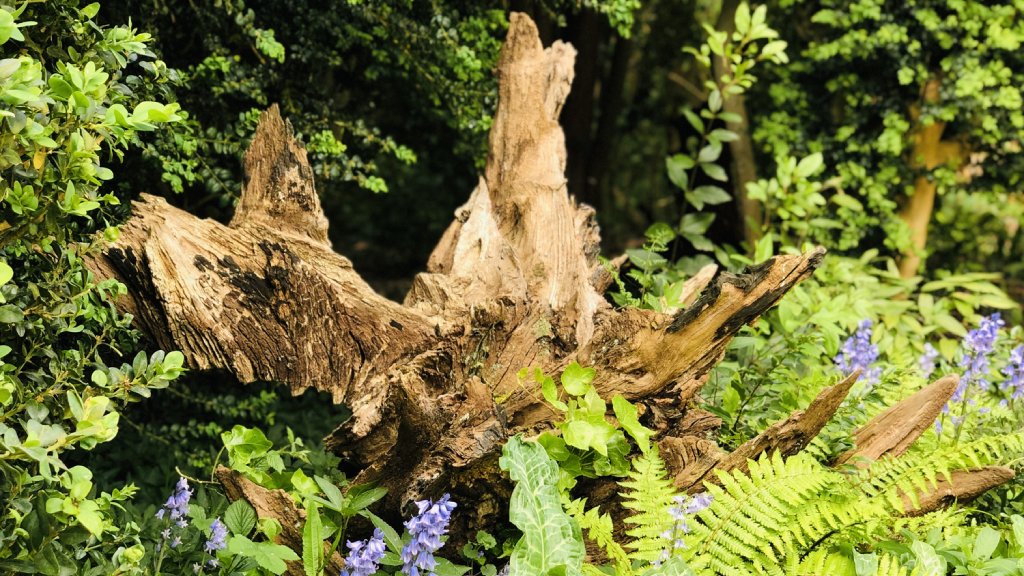Victorian Stumpery Gardens: A Traditional Way To Garden Sustainability
A Victorian stumpery garden turns a sun-deprived spot into an enchanting, environmentally friendly wonderland of ferns and shade loving plants.


The Victorian era was famed for its gardens, and tree stump gardens were a feature of them. These gorgeous landscapes use a creative mix of stumps and rocks to create unusual garden structures. Like rock gardens, tree stump gardens mix living plants - including ferns - in irregular compositions with large elements. The goal is to create habitats for ferns and other shade-loving plants, using the arresting architecture of the roots.
Victorian stumpery gardens are regaining popularity these days as modern gardeners again appreciate their simplicity and timeless appeal. If you are considering installing this type of fern garden, it’s time to get inspired with some exciting stumpery garden ideas.
What Made Victorian Stumpery Gardens So Popular?
Garden trends come and go these days, but trends are not just a component of modern society. Even in the Victorian era, garden styles were dictated by fashion trends. One of the longest and strongest obsessions of the nineteenth century was the fern craze, also known as “Pteridomania.” Ferns were everywhere, in gardens, on textiles, and decorating lavish ceramics. This trend roared on until the middle of the twentieth century.
Gardeners today haven’t been bitten by the fern bug, but there is a growing interest in sustainable gardening, including encouraging wildlife and supporting beneficial insects. Victorian stumpery gardens are not only lush and lovely but are great for biodiversity and wildlife. They also provide an environmentally friendly method to repurpose tree stumps.
Inspirational Victorian Stumpery Gardens
Anyone considering installing a stumpery garden can find inspiration from famous gardens from the Victorian era. The best-known are found in the United Kingdom, but there are some in North America as well.
The Biddulph Grange in Staffordshire might be the most famous Victorian stumpery in Europe, and is certainly among the oldest. It was designed in 1856 by James Bateman and Edward William Cooke. This private estate was taken over by the National Trust, at which time the stumpery was restored. It is made from stumps piled up to enclose a sunken pathway leading to a garden of ferns and mosses.
How about a royal stumpery? The private Gloucestershire residence of King Charles III is not the oldest stumpery in Britain - it was created in 1996 - but it is the largest one. It was designed by Charles himself, along with designers Julian and Isabel Bannerman, using stumps of sweet chestnut to frame the various pathways and also as stand-alone islands. The garden overflows with shade-loving plants including hostas, ferns, and mosses.
Sign up for the Gardening Know How newsletter today and receive a free copy of our e-book "How to Grow Delicious Tomatoes".
How To Recreate The Effect in Your Garden
Although stumperies trended wildly in the Victorian era, they did not all look alike. In fact, each is different and distinct. This makes creating a stumpery exciting. Different tree stumps look different, since they are distinct species, of different ages, and have different shapes. Yet you can certainly get inspired by using some of the stumpery garden ideas you see in these famous gardens.
Make More of Ferns and Mosses
The goal of a stumpery is the creation of habitats especially for ferns and other shade-loving plants; secondarily comes the sense of accomplishment from the arrangements of the arresting architecture of the roots, or any other things that you can find on or in re-purposed wood.

Teo Spengler is a master gardener and a docent at the San Francisco Botanical Garden, where she hosts public tours. She has studied horticulture and written about nature, trees, plants, and gardening for more than two decades, following a career as an attorney and legal writer. Her extended family includes some 30 houseplants and hundreds of outdoor plants, including 250 trees, which are her main passion. Spengler currently splits her life between San Francisco and the French Basque Country, though she was raised in Alaska, giving her experience of gardening in a range of climates.